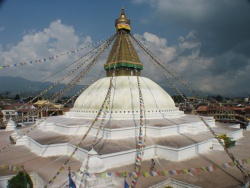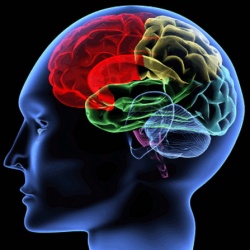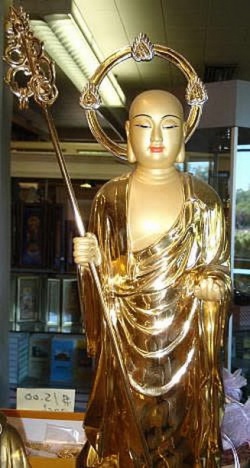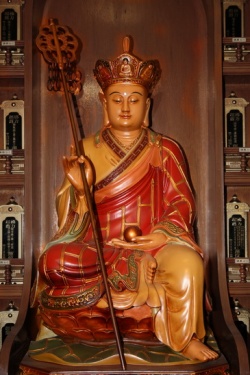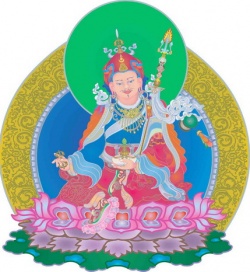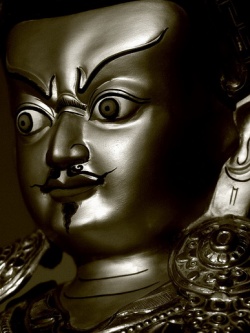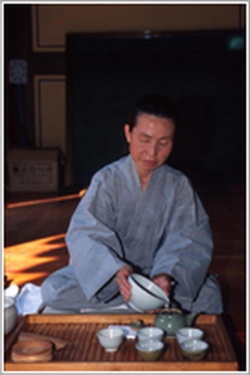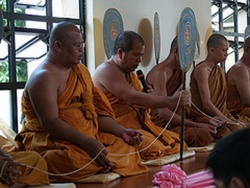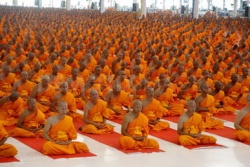Anussati
Anussati (Pāli; Sanskrit: Anusmriti) means "recollection," "contemplation," "remembrance," "Meditation" and "Mindfulness."
In Buddhism, anussati refers to either:
specific Meditative or devotional practices, such as recollecting the sublime qualities of The Buddha, which lead to Mental tranquillity and abiding Joy; or,
Meditative attainment, such as the ability to recollect past lives.
anussati: 'recollection', meditation, contemplation.
]
The six recollections often described in the Suttas (e.g. A. VI, 10, 25; D. 33) are:
(1) recollection of the Buddha,
(2) his Doctrine,
(3) his Community of noble disciples,
(4) of morality,
(5) liberality,
(6) heavenly beings (buddhānussati, dhammānussati, saṃghānussati, sīlānussati, cāgānussati, devatānussati).
(1) "The noble disciple, Mahānāma, recollects thus: 'This Blessed One is holy, a fully Enlightened One, perfected in wisdom and conduct, faring happily, knower of the worlds, unsurpassed leader of men to be trained, teacher of heavenly beings and men, a Buddha, a Blessed One.'
(2) 'Well proclaimed by the Blessed One is the Doctrine (Dhamma), directly visible, with immediate fruit, inviting investigation, leading on to Nibbāna, to be comprehended by the wise, each by himself.'
(3) 'Of good conduct is the Community (Saṃgha) of the Blessed One's disciples, of upright conduct, living on the right path, performing their duties, to wit: the 4 pairs of men or 8 individuals (s. ariya puggala).
This Community of the Blessed One's disciples is worthy of offerings, worthy of hospitality, worthy of gifts, worthy of reverence with raised hands, the unsurpassed field for doing meritorious deeds.'
(4) "The noble disciple further recollects his own morality (sīla) which is unbroken, without any breach, undefiled, untarnished, conducive to liberation, praised by the wise, not dependent (on craving or opinions), leading to concentration.
(5) "The noble disciple further recollects his own liberality (cāga) thus: 'Blessed truly am I, highly blessed am I who, amongst beings defiled with the filth of stinginess, live with heart free from stinginess, liberal, open-handed, rejoicing in giving, ready to give anything asked for, glad to give and share with others.'
(6) "The noble disciple further recollects the heavenly beings (devatā): 'There are the heavenly beings of the retinue of the Four Great Kings, the heavenly beings of the World of the Thirty-Three, theYāmadevas ... and there are heavenly beings besides (s. deva). Such faith, such morality, such knowledge, such liberality, such insight, possessed of which those heavenly beings, after vanishing from here, are reborn in those worlds, such things are also found in me.' " (A. III,70; VI,10; XI,12).
"At the time when the noble disciple recollects the Perfect One ... at such a time his mind is neither possessed of greed, nor of hate, nor of delusion. Quite upright at such a time is his mind owing to the Perfect One ... With upright mind the noble disciple attains understanding of the sense, understanding of the law, attains joy through the law. In the joyous one rapture arises.
With heart enraptured, his whole being becomes stilled. Stilled within his being, he feels happiness; and the mind of the happy one becomes firm. Of this noble disciple it is said that amongst those gone astray, he walks on the right path, among those suffering he abides free from suffering. Thus having reached the stream of the law, he develops the recollection of the Enlightened One...." (A. VI, 10).
In A. I, 21 (PTS: I, xvi) and A. I, 27 (PTS: xx. 2) another 4 Recollections are added: Mindfulness on Death (maraṇa-sati, q.v.), on the Body (kāyagatā-sati, q.v.), on Breathing (ānāpāna-sati, q.v.), and the Recollection of Peace (upasamānussati, q.v.).
The first six recollections are fully explained in Vis.M. VII, the latter four in Vis.M. VIII.
Sets of recollections
In various contexts, the Pali literature and Sanskrit Mahayana sutras emphasize and identify different enumerations of recollections.
Three recollections
The Three Recollections:
Recollection of The Buddha (Pali Buddhānussati, Skt. Buddhanusmrti, Tib. Sans- rgyas -rjes-su dran pa)
Recollection of the Dhamma (Pali Dhammānussati, Skt. Dharmanusmrti, Tib. Chos- rjes- su dran pa)
Recollection of The Sangha (Pali Saṅghānussati, Skt. Sanghanusmrti: Tib. dge -hdun- rjes- su dran pa)
The Dhammapada declares that The Buddha's disciples who constantly practice recollection of the Three Jewels "ever awaken happily."
According to the Theragatha, such a practice will lead to "the height of continual Joy."
Unlike other subjects of Meditative recollection mentioned in this article, the Three Jewels are considered "devotional contemplations." The Three Jewels are listed as the first three subjects of recollection for each of the following lists as well.
Five recollections
On a Buddhist sabbath (Uposatha) day, in addition to practicing the Eight Precepts, The Buddha enjoined a Disciple to engage in one or more of Five Recollections:
Recollection of The Buddha
Recollection of the Dhamma
Recollection of The Sangha
Recollection of Virtue (Sīlānussati)
Recollection of Deva virtues (devatānussati)
According to The Buddha, for one who practices such recollections: "'his Mind is calmed, and Joy arises; the Defilements of his Mind are abandoned.'"
Six recollections
The Six Recollections are:
Recollection of The Buddha
Recollection of the Dhamma
Recollection of The Sangha
Recollection of Generosity (cāgānussati)
Recollection of Virtue
Recollection of Deva virtues
The Buddha tells a Disciple that the Mind of one who practices these recollections "is not overcome with passion, not overcome with aversion, not overcome with Delusion.
His Mind heads straight, ... gains Joy connected with the Dhamma..., rapture arises..., the Body grows calm ... experiences ease..., the Mind becomes concentrated."
In Mahayana practice, the first six recollections were commonly taught and The Buddha anusmriti was particularly emphasized in many popular sutras such as the Medicine Buddha Sutra.
Ten recollections
As Ten Recollections, the following are added to the Six Recollections:
Recollection of Death (Mara ṇānussati)
Recollection of the Body ([[kāyagatā Sati)
Recollection of the Breath (ānāpānassati)
Recollection of peace (upasamānussati)
In the [[Pal] canon's]] Anguttara Nikaya, it is stated that the practice of any one of these ten recollections leads to Nirvana.
The Visuddhimagga identifies the Ten Recollections as useful Meditation subjects for developing Concentration needed to suppress and destroy the Five Hindrances during ones pursuit of Nibbana.
In terms of the development of Meditative absorption, Mindfulness of the Breath can lead to all four jhanas, Mindfulness of the Body can lead only to the first Jhana, while the eight other recollections culminate in pre-jhanic "access Concentration" (upacara Samadhi).
Specific subjects of recollection
As indicated in the above sets, the following are recollected subjects of either Meditation or devotion.
Recollection of The Buddha
The standard formula when recollecting The Buddha is:
Iti pi so bhagavā arahaṃ sammā-saṃbuddho vijjācaraṇasaṃpanno sugato lokavidū anuttaro purisadammasārathī satthā devamanussānaṃ buddho bhagavā ti
'Indeed, the Blessed One is worthy and rightly self-Awakened, consummate in Knowledge & conduct, well-gone, an expert with regard to the World, unexcelled as a trainer for those people fit to be tamed, the Teacher of divine & human beings, Awakened, blessed.'
It has been suggested that the Recollection of The Buddha identified in the Theravada canon might have been the basis for the more elaborately visual contemplations typical of Tibetan Buddhism.
Recollection of the Dhamma
The standard formula when recollecting the Dhamma is:
'The Dhamma is well-expounded by the Blessed One, to be seen here & now, timeless, inviting verification, pertinent, to be realized by the wise for themselves.'
Recollection of The Sangha
The standard formula when recollecting The Sangha is:
'The Sangha of the Blessed One's disciples who have practiced well... who have practiced straight-forwardly... who have practiced methodically... who have practiced masterfully — in other words, the four types [of noble disciples) when taken as pairs, the eight when taken as individual types — they are The Sangha of the Blessed One's disciples: worthy of gifts, worthy of Hospitality, worthy of offerings, worthy of respect, the incomparable field of Merit for the World.'
Recollection of actual past lives
For one accomplished in Meditative Concentration, there is the possibility of attaining the recollection of one's own past lives (pubbenivāsānussati). In this case, anussati is not a Meditative subject to achieve jhanic absorption or devotional bliss; it is the actual fruit of practice.
An example of one who has achieved such a Power is described in the following manner by The Buddha in the "Lohicca Sutta" (DN 12):
"With his Mind thus concentrated, purified, & bright, unblemished, free from defects, pliant, malleable, steady, & attained to imperturbability, he directs & inclines it to Knowledge of the recollection of past lives (lit: previous homes).
He recollects his manifold past lives, i.e., one birth, two births, three births, four, five, ten, twenty, thirty, forty, fifty, one hundred, one thousand, one hundred thousand, many aeons of cosmic contraction, many aeons of cosmic expansion, many aeons of cosmic contraction & expansion, [recollecting],
'There I had such a name, belonged to such a clan, had such an appearance. Such was my Food, such my experience of pleasure & pain, such the end of my Life. Passing away from that state, I re-arose there. There too I had such a name, belonged to such a clan, had such an appearance.
Such was my Food, such my experience of pleasure & pain, such the end of my Life. Passing away from that state, I re-arose here.' Thus he recollects his manifold past lives in their modes & details...."

